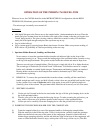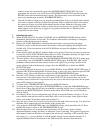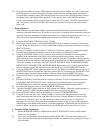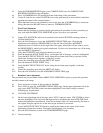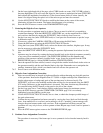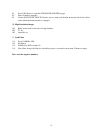2.13 If the operator intends to expose TEM negatives using the built-in camera, it is best to ensure that
the CCD camera is retracted and shut off so that it cannot interfere with the shutter mechanism.
Using the Mac computer, whose CRT and keyboard rest on top on the CM-200 operating console,
the operator may open Digital Micrograph (if it is not already open), select MSC from the top
toolbar, and from that pull-down menu click to retract the CCD camera. The CCD camera control
unit, which rests to the left of the Mac CRT, may also be turned off using the red switch on the
front. Left.
3. Beam Alignment
These functions are performed without a specimen in the holder and may be performed without
inserting a specimen holder at all. If a holder is not in place, a radiation safety interlock prevents the
spot size from being changed to a number lower than 5 (the largest and brightest spot size is no. 1).
This will produce a much dimmer beam image than that seen with the holder in place.
3.1 Using the MAGNIFICATION knob, select 17,500x.
3.2 Defocus the electron beam by turning the INTENSITY knob clockwise to strongly overfocus the
C2 lens. Bring the beam back to crossover (the smallest image of the beam) and center it using the
SHIFT X/Y knobs.
3.3 Choose a C2 aperture (usually position 3, which is a 100-micron aperture) by rotating the largest
knurled knob on the topmost aperture control on the column to the desired position.
3.4 Using the INTENSITY knob, slowly overfocus (turn clockwise) the beam to coincide with the
diameter of the intermediate-sized black circle on the phosphorescent viewing screen. If the
defocused beam is not coincident with the circle, adjust it using the C2 aperture centering controls.
These are both the intermediate-sized knurled knob on the aperture rod and the knurled knob on the
side of the assembly (to the right). DO NOT TOUCH THE SMALLEST, INNERMOST KNOB
BECAUSE IT UNSCREWS THE APERTURE ROD. Repeat these steps (3 and 5) until the beam
spreads uniformly around the reference circle while being over focused (INTENSITY knob).
3.5 Using the INTENSITY knob, adjust the beam to crossover. Depress the FINE button (to the left of
the INTENSITY knob; the indicator light turns green when it is on) and use the INTENSITY knob
to sharpen the de-saturated filament image. Center the image using the SHIFT X/Y knobs.
3.6 Press the STIG button, on the right-hand instrument panel, to open the STIGMATOR CONTROL
page.
3.7 Press the COND key on the data monitor screen to select the C2 lens for astigmatism correction.
Use the MULTIFUNCTION X/Y knobs, while rotating the beam through crossover using the
INTENSITY knob, to obtain the cleanest, roundest de-saturated filament image possible.
3.8 Press the STIG button to return to the CONFIGURATION page.
3.9 Turn the FILAMENT knob clockwise to fully saturate the filament. When the saturation point (as
defined by the FIL LIMIT) has been reached, the microscope will emit a 'beep.'
3.10 Press the READY button and then the TEM key to return to TEM BRIGHTFIELD.
3.11 Using the lever to the left of the viewing chamber, lower the small phosphorescent screen into
place. Insert the beam stop (at the right-hand side top of the viewing chamber) so that it will be
visible across the small screen. Use the binoculars to observe the beam stop. To adjust the
binoculars for your eyes, first adjust the interpupillary distance so that you can see through them
with both eyes; then adjust each eyepiece so that the rough edges of the beam stop are in focus for
each eye. When you are done, retract the beam stop and lift the small screen back out of view.
4. Eucentric Height Adjustment
4.1 Set the MAGNIFICATION to 5,800x and use the X/Y JOYSTICK to center a small notable
feature of your specimen.
4.2 Focus your chosen feature using the knobs marked STEP SIZE. The outer knob changes the
focus; the inner knob (the step size adjustment) modifies the amount of focus change per 'click' of
the outer knob.
3



